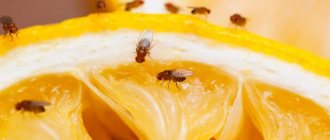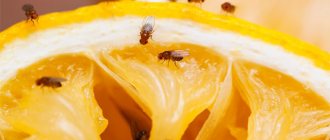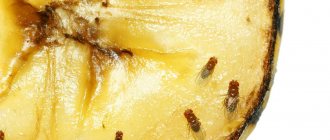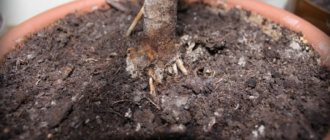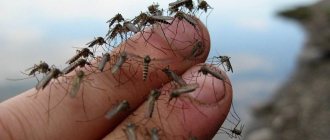Indoor flowers are the joy of every housewife. Thanks to them, comfort and harmony reign in the rooms. And the air is significantly enriched with oxygen. Even regular care of your “green friends” does not guarantee that pests will not infest them. Almost every amateur gardener in his life has encountered such a harmful insect as the flower midge - a small black insect with wings that always catches the eye and irritates with its intrusiveness. If you have midges in your indoor flowers, you will learn how to get rid of them and what products are best to use in this article.
Midges in indoor flowers
Parasites often appear in plants in winter. It is at this time that the plants are weak. When small midges are found in indoor plants, first of all you need to determine to what stage the damage to the flower has reached. Damage is caused both by the insects themselves and their larvae. If you do not immediately resort to any measures, the flower will die.
Initially, it is recommended to dig out the soil in the flower pot and make sure that there are no fly larvae there. After all, getting rid of midges is much easier than getting rid of their larvae.
Other pests
In addition to pords and sciarids, flowers are attacked by other, no less dangerous insects. Common pests of indoor flowers include:
- Thrips (vesicles) are insects 1-2 mm long. Thrips have an elongated shape, adults are gray-brown in color, larvae are yellow. Thrips reproduce quickly, laying eggs in leaves and buds. Insects feed on rhizomes.
- Aphids are small insects 1-2 mm long. Aphids can be green, but also brown, red, black or yellow. The main diet is young shoots and buds. The aphid pierces the surface of the leaf shoot with its proboscis and sucks out the juice.
- Red spider (spider mites) are insects with a characteristic red color. Appear on plants located in a dry, unventilated area. When attacked by a mite, the flowers become pale, the leaves gradually dry out and fall off.
- The scale insect (shield aphid) is easily recognized by the presence of a removable shell. Scale insects feed by tightly adhering to leaves and stems, causing irreparable damage to indoor plants.
- The mealybug is a pest whose shell is covered with a white dusty coating. It is possible to detect a mealybug only when there is a large concentration of it.
80 of the most beautiful flowers in the world with photos, names and descriptions
Varieties of midges in flowers and flower pots
Flower midges can be classified as insects of the Diptera family. They number about 2000 subspecies. Let's list the most common ones.
White midges on flowers - whiteflies, scale insects
White midges , called whiteflies or scale insects , look very similar to aphids. Among indoor plants in pots, soft leaves of fuchsia or begonia are preferred.
White midges on house flowers are whiteflies, also called “scale insects.”
Black midges in flowers - sciarids
Black midges living in home flowers are called sciarids , and another name for these parasites is fungus gnats . They prefer to live near the root system of flowers such as aloe, Decembrist, ficus, azalea. For humans, this type of insect creates considerable inconvenience in the apartment - it gets into food or drink. Settling in the soil where the flower grows, they make it dense and impervious to air, thus causing enormous damage to the roots of the plants.
Black midges on house flowers are called sciarids or fungus gnats
Ground fleas in flower pots - fools
Podura ( ground fleas - white flies ), the second name is springtails . These are jumping wingless parasites. You can see them in places where there is high humidity (the bottom of a pot, a wet tray, the top of the soil of a heavily watered flower). White larvae of podurs cause damage to plant roots. They differ from other parasites in their speed and jumping if someone wants to touch them.
White insects that are found in the soil of home flowers - podras or springtails
Signs of infection
Midges are too small to immediately detect their presence. They hide under leaves and in moist soil. Only when they reach a huge number do they reveal themselves. In most cases, the larvae are found in the ground, in the area of the root system, so it is quite difficult to see them. Despite the “secrecy”, there are some signs that allow you to accurately determine the presence of parasites. These include:
- the occurrence of diseases;
- the appearance of a whitish coating on the leaves and stems;
- the substrate or soil becomes crumbly;
- the ground “fades” a little.
The most vulnerable species are considered to be:
- fuchsia;
- azalea;
- ficus;
- aloe;
- epiphytic cacti;
- gerberas;
- violets;
- begonias.
Why are there small midges in indoor flowers?
It is important not to forget that excessively moist soil is the best place for midges to exist and reproduce. So, if you do not want to breed white bugs in the soil of indoor plants, then you should not neglect attention to the soil in pots.
The main source of reproduction of flower parasites is considered to be excess moisture in the soil of indoor flowers.
Secondary reasons for the appearance of harmful insects include:
- Pouring low-quality soil into flower pots. It leads to an invasion of harmful midges, the larvae of which will already live in the soil. As a result, you will need to quickly look for ways to get rid of the emerging parasites.
- The appearance of insects can be facilitated by transplanting plants into huge pots. The soil at the bottom of the flower pot is most saturated with moisture, only the root system of the plant does not reach there. High humidity is a suitable breeding ground for pests.
- The use of organic fertilizers will also encourage the appearance of bugs. Even if the soil is watered moderately, the presence of organic impurities will attract midges, which will settle well on the indoor plant.
- A fly can fly into an apartment from another living space, from the basement, through ventilation or an exhaust pipe. Moreover, the flying insects immediately find suitable flower pots with abundantly moistened soil.
Why are uninvited guests dangerous?
Indoor plants are both a home and a source of food for midges.
Insects feed on sap from stems and leaves and infect the roots. Because of this, the infected plant withers. Its foliage becomes limp and it reacts poorly to feeding. And then it dies completely.
The result of exposure to scale insects
In addition, when feeding on juices, pests leave microscopic wounds on stems, leaves and roots. Through these wounds, flowers become infected with fungal, bacterial and infectious diseases. Their carriers, by the way, are the same flower midges.
That is why, simultaneously with parasites, flowers often suffer from various fungal diseases. But not every plant can withstand such a double blow to the immune system.
IMPORTANT! If midges are not dealt with, they will very quickly spread throughout the house. And instead of just one sick pet, you get an epidemic.
Ways to get rid of midges in house plants
There are many ways to get rid of these harmful parasites - both chemical and folk. To get rid of insects, you should resort to the following measures.
First of all, when flower midges are detected, it is necessary to remove the affected flower away from other plants.
Flower soil in which insects have already settled should be thrown away. The flower is removed from the pot, the root system is washed and the already treated plant is transplanted into disinfected soil. There is an option to replace the top layer of soil.
If it is not possible to change the affected soil, it is recommended to treat it with an insecticide. More effective drugs against flower flies include Fitoverm , Aktara , Tanrek . Flycatcher insecticide , which is available in granules, is also effective in combating annoying midges.
If there are not too many pests yet, then fly sticky tape hung next to the flower pots will help catch them.
If there are already a lot of insects, then it is recommended to use aerosol preparations for destruction, such as Dichlorvos and Raptor . By lightly spraying the product, treat window sills, shelves, and walls located near house plants. Plus, the soil in the flower pot and its bottom. The result of the treatment will be the death of adult individuals and their eggs laid in the ground.
Another good remedy for midges is to reduce the number of waterings of the flower that has been affected by parasites. Dry soil will contribute to the death of the larvae.
Still, the best way to combat midges is to follow all the rules for the care and maintenance of house plants.
Folk remedies for midges in flowers
Midges have appeared in flowers - the problem arises of what means to use to rid your favorite plants of them without harm. One of the ways to independently remove irritable insects is to use various folk remedies.
An effective folk remedy against flies is garlic . The smell of garlic has a detrimental effect on some insects, including flower midges. Just two procedures - and black midges completely die. To prepare the required solution, take three heads of garlic and chop them using a garlic press. The resulting mass is poured with one liter of boiled water. After 4 hours, strain. The leaves of the plants are sprayed with this solution and the soil in the pot is treated.
If soil flies are detected, a solution of potassium permanganate . The soil in the pot is being cultivated. It is recommended to repeat watering the damaged flower after 2 days. In order not to harm the roots of the plant, the solution should be weak.
You can kill flower flies in the soil of a houseplant using soap . To do this, you need to grate laundry soap (20g) and fill it with 1 liter of water. The resulting soap solution is used to treat the leaves and water the soil in the pot.
You can also get rid of flower midges using regular matches . In a pot with a flower, you should deepen about five matches of sulfur into the soil and lightly water the soil. Matches in flowers are replaced every day, as sulfur dissolves in the soil. A certain number of such procedures will rid the plant of both midges and their larvae.
Wood ash is an equally effective folk remedy in the fight against insects on indoor flowers. The soil in the pot is simply covered with such ash and the midges will forever leave the flower they have chosen alone. Plus, wood ash is considered an excellent fertilizer that gives the plant strength.
tobacco helps fight bugs . To prepare the tincture, take 50g of dried tobacco and add one liter of water. Infuses for 2 days. The resulting tincture is sprayed onto the leaves of the flower. The disadvantage is that tobacco tincture has a detrimental effect only on adult insects; the larvae do not die from it.
Ground flies do not like the smell of mint . The edge of the pot can be smeared with the well-known “Star”. This will help get rid of harmful insects.
Celandine tincture (100g of celandine per 1 liter of boiled water) also gets rid of annoying bugs. Treated by spraying plant leaves.
You can also destroy insects in house plants using ammonia . In addition, it improves plant growth. The solution can be prepared by taking 50 ml of ammonia and diluting it in 4 liters of water.
Orange peels also help get rid of harmful insects that attack indoor flowers. The citrus smell irritates them. It is recommended to cover the flower pot with such crusts or to deepen them directly into the soil. The pests will blow away like the wind.
Or you can simply dry the soil . Also an excellent way to combat flower midges. Until the soil is completely dry, it is not advisable to water your “green friend”. Then cover the top of the soil with fried sand and sprinkle it with weak potassium permanganate.
Treatment of infected plants with folk remedies is considered the safest method compared to the use of chemicals.
Prevention measures
To prevent the appearance of flower midges, you need to follow certain rules, namely:
- Regulate the intensity of watering, especially in the cold season, when moisture evaporates from the soil rather slowly.
- Provide drainage using sand, pebbles, charcoal or expanded clay to prevent the soil from becoming waterlogged.
- Use mosquito nets for windows to prevent pests from entering through the window.
- When purchasing a new flowerpot, you should transplant it into another pot, having first cleaned the roots of the plant, and douse the pot itself with boiling water or steam.
- Steam the soil for planting in a water bath.
- Prevent the breeding of insects by covering the soil surface with pebbles or granite chips.
- Regularly loosen the soil of the plant.
- Inspect the flowers for dry leaves and damage.
- For fertilizing, use exclusively mineral fertilizers.
Flower midge is a dangerous pest from which no one is safe. It is easier to prevent its occurrence than to deal with the destruction and further treatment of a damaged plant. To do this, it is necessary to observe preventive measures, as well as carefully monitor the condition of house plants.
Effective insecticides to control midges
But, in some cases, the use of folk remedies only temporarily rids the houseplant of parasites. Time passes, they appear again. Therefore, in order to forget about flower flies forever, it is recommended to resort to the use of chemicals. There are both liquid insecticides, which can be sprayed and watered, and granular ones, intended for mixing with the soil.
It is best to opt for safe drugs. When processing plants, be sure to use personal protective equipment.
The liquid and safest insecticides include “ Agravertin ”, “ Fitoverm ”, “ Fufanon ”, “ Aktara ”, “ Inta-vir ”. These chemicals can be used at home. The course of treatment is carried out over two weeks. Watering the plant is done once a week. After the plant has been watered with an insecticide, it is not advisable to water it with clean water for 5 days.
Dangerous liquid insecticides include Actellik , which has very high toxicity. Its use is prohibited in residential premises.
Granular insecticides include “ Bazudin ”, “ Grom-2 ”, “ Fly-eater ”. The main thing is to mix the granules with the top layer of soil, and not just scatter them on top of the ground. These insecticides do not act as quickly, but they are just as effective as liquid ones.
Do not forget that absolutely all chemicals are toxic. When processing plants, you must wear gloves, safety glasses and a respirator. After work, be sure to ventilate the room.
Bona Forte ), which can paralyze flying pests in an instant, are considered very effective and easy to use Aerosol and spray consist of substances that are harmless to humans and the environment.


